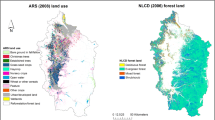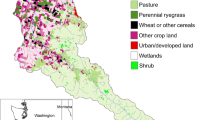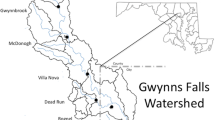Abstract
Human activities have greatly increased the input of biologically available nitrogen (N) from land-based sources to aquatic ecosystems; yet few studies have examined how human actions influence N export in regions with a strong seasonality in water availability. In this study, we quantified N inputs and outputs for 23 California watersheds and examined how climate, hydrology, and land use practices influenced watershed N export. N inputs ranged from 581 to 11,234 kg N km−2 year−1 among watersheds, with 80% of total input for the region originating from agriculture (inorganic fertilizer, manure, and legumes). Of the potential N sources examined, mean annual concentrations of dissolved organic N and dissolved inorganic N in study rivers correlated most strongly with manure N input (r 2 = 0.54 and 0.53, respectively). Seasonal N export varied by basin and was correlated with climate, anthropogenic N inputs, and reservoir releases. Fractional export of watershed N inputs by study rivers annually was small (median of 8%) and scaled exponentially with runoff (r = 0.66). Collectively, our results show that anthropogenic activities have altered both the magnitude and timing of watershed N export in California and suggest that targeted management in specific locations and times of the year could reduce N export to downstream systems in the region.






Similar content being viewed by others
References
Ahearn DS, Sheibley RW, Dahlgren RA (2005a) Effects of river regulation on water quality in the lower Mokelumne River, California. River Res Appl 21:651–670. doi:10.1002/rra.853
Ahearn DS, Sheibly RW, Dahlgren RA et al (2005b) Land use and land cover influence on water quality in the last free-flowing river draining the western Sierra Nevada, California. J Hydrol 313:234–247. doi:10.1016/j.jhydrol.2005.02.038
Alexander RB, Smith RA, Schwarz GE et al (2008) Differences in phosphorus and nitrogen delivery to the Gulf of Mexico from the Mississippi River Basin. Environ Sci Technol 42:822–830. doi:10.1021/es0716103
Battaglin WA, Goolsby DA (1994) Spatial data in geographic information system format on agricultural chemical use, land use, and cropping practices in the United States (USGS Water Res Inv Rep 94-4176; http://water.usgs.gov/pubs/wri/wri944176/)
Bouwman AF, Van der Hoek KW, Eickhout B et al (2004) Exploring changes to the world ruminant production system. Agric Syst 84:121–153. doi:10.1016/j.agsy.2004.05.006
Bouwman AF, Van Drecht G, van der Hoek KW (2005a) Global and regional surface nitrogen balances in intensive agricultural production systems for the period 1970–2030. Pedosphere 15:137–155
Bouwman AF, Van Drecht G, Knoop JM et al (2005b) Exploring changes in river nitrogen export to the world’s oceans. Global Biogeochem Cycles 19:GB1002. doi:10.1029/2004GB002314
Boyer EW, Goodale CL, Jaworski NA et al (2002) Anthropogenic nitrogen sources and relationships to riverine nitrogen export in the northeastern U.S.A. Biogeochemistry 57:137–169. doi:10.1023/A:1015709302073
Bricker SB, Clement CG, Pirhalla DE et al (1999) National Estuarine Eutrophication Assessment. Effects of nutrient enrichment in the nation’s estuaries. NOAA-NOS special projects office, Silver Spring, MD
Brookshire ENJ, Valett HM, Thomas SA et al (2007) Atmospheric N deposition increases organic N loss from temperate forests. Ecosystems 10:252–262. doi:10.1007/s10021-007-9019-x (NY print)
Busse M (2000) Suitability and use of the 15N-isotope dilution method to estimate nitrogen fixation by actinorhizal shrubs. For Ecol Manag 136:85–95. doi:10.1016/S0378-1127(99)00264-9
Bytnerowicz A, Fenn ME (1996) Nitrogen deposition in California forests: a review. Environ Pollut 92:127–146. doi:10.1016/0269-7491(95)00106-9
California Department of Forestry and Fire Protection & USDA Forest Service, LCMMP (2005) Vegetation data for California. http://frap.cdf.ca.gov/projects/land_cover/index.html
California Department of Water Resources, CDWR (2008) California Department of Water Resources Data Exchange Center. http://136.200.137.25/
California Regional Water Quality Control Board, CRWCB (2004) Conditional waiver of waste discharge requirements for discharges from irrigated lands. San Luis Obispo, CA R3-2004-0117:1
Caraco NF, Cole JJ (2001) Human influence on nitrogen export: a comparison of mesic and xeric catchments. Mar Freshw Res 52:111–125. doi:10.1071/MF00083
Carlson RM (1978) Automated separation and conductimetric determination of ammonia and dissolved carbon dioxide. Anal Chem 50:1528–1531. doi:10.1021/ac50033a035
Carlson RM (1986) Continuous flow reduction of nitrate to ammonia with granular zinc. Anal Chem 58:1590–1591. doi:10.1021/ac00298a077
Casals P, Romanya J, Vallejo V (2005) Short-term nitrogen fixation by legume seedlings and resprouts after fire in Mediterranean old-fields. Biogeochemistry 76:477–501. doi:10.1007/s10533-005-8659-1
Cleveland CC, Townsend AR, Schimel DS et al (1999) Global patterns of terrestrial biological nitrogen (N2) fixation in natural ecosystems. Global Biogeochem Cycles 13:623–645. doi:10.1029/1999GB900014
Dahlgren RA, Kratzer CR, Bergamaschi BA et al (2008) Water quality characteristics of riparian-zone groundwater of the lower San Joaquin River, California. 5th Biennial CALFED science conference 2008 global perspectives and regional results: science and management in the Bay-Delta system. October 2008, Sacramento, CA
Domagalski JL, Knifong DL, Dileanis PD et al (2000) Water quality in the Sacramento River basin, California, 1994-98. US Geological Survey Circular 1215 (36 pp)
Donner SD, Coe MT, Lenters JD et al (2002) Modeling the impact of hydrological changes on nitrate transport in the Mississippi River Basin from 1955 to 1994. Global Biogeochem Cycles 16:1043. doi:10.1029/2001GB001396
Driscoll CT, Whitall D, Aber J et al (2003) Nitrogen pollution in the Northeastern United States: sources, effects, and management options. BioSci 53:357–373. doi:10.1641/0006-3568(2003)053[0357:NPITNU]2.0.CO;2
Dumont E, Harrison JA, Kroeze C et al (2005) Global distribution and sources of dissolved inorganic nitrogen export to the coastal zone: results from a spatially explicit, global model. Global Biogeochem Cycles 19:GB4S02. doi:10.1029/2005GB002488
Economic Research Service-US Department of Agriculture, ERS/USDA (2008) US fertilizer use and price (http://www.ers.usda.gov/Data/FertilizerUse/)
Eickhout B, Bouwman AF, van Zeijts H (2006) The role of nitrogen in world food production and environmental sustainability. Agric Ecosyst Environ 116:4–14. doi:10.1016/j.agee.2006.03.009
Gronberg JM, Dubrovsky NM, Kratzer CR et al (1998) Environmental setting of the San Joaquin-Tulare basins, California. Water-resources investigations report 97-4205
Gruber N, Galloway JN (2008) An earth system perspective of the global nitrogen cycle. Nature 451:293–296
Harrison JA, Caraco N, Seitzinger SP (2005) Global patterns and sources of dissolved organic matter export to the coastal zone: results from a spatially explicit, global model. Global Biogeochem Cycle 19:GB4S04. doi:10.1029/2005GB002480
Harrison J, Maranger R, Alexander R et al (2008) The regional and global significance of nitrogen removal in lakes and reservoirs. Biogeochemistry 93:143–157. doi:10.1007/s10533-008-9272-x
Helliwell RC, Coull MC, Davies JJL et al (2007) The role of catchment characteristics in determining surface water nitrogen in four upland regions in the UK. Hydrol Earth Syst Sci 11:356–371
Holloway JM, Dahlgren RA (2001) Seasonal and event-scale variations in solute chemistry for four Sierra Nevada catchments. J Hydrol 206:106–121
Howarth RW, Swaney DP, Boyer EW et al (2006) The influence of climate on average nitrogen export from large watersheds in the northeastern United States. Biogeochemistry 79:163–186
Jassby AD, Reuter JE, Axler RP et al (1994) Atmospheric deposition of nitrogen and phosphorus in the annual nutrient load of Lake Tahoe (California-Nevada). Wat Res Res 30:2207–2216
King Jr J, Dellavalle N, Beckley S et al (1999) Air quality and fertilization practices: establishing a calendar of nitrogen fertilizer application timing practices for major crops in the San Joaquin Valley. California Department of Food and Agriculture FREP Contract # 98-0471 II. http://www.cdfa.ca.gov/is/docs/King99%5B1%5D.pdf
Kratzer CR, Shelton JL (1998) Water quality assessment of the San Joaquin–Tulare Basins, California: analysis of available data on nutrients and suspended sediment in surface water, 1972–1990. US Geological Survey professional paper 1587
Kratzer CR, Dileanis PD, Zamora C et al (2004) Sources and transport of nutrients, organic carbon and chlorophyll-a in the San Joaquin River upstream of Vernalis, California, during summer and fall, 2000 and 2001. US Geological Survey water-resources investigations report 03-417
Lagerstrom A, Nilsson MC, Zackrisson O et al (2007) Ecosystem input of nitrogen through biological fixation in feather mosses during ecosystem retrogression. Func Ecol 21:1027–1033
McIsaac GF, Hu X (2004) Net N input and riverine N export from Illinois agricultural watersheds with and without extensive tile drainage. Biogeochemistry 70:251–270
McKnight TL, Hess D (2000) Physical geography. Prentice Hall, Englewood Cliffs
Mulholland PJ, Helton AM, Poole GC et al (2008) Stream denitrification across biomes and its response to anthropogenic nitrate loading. Nature 452:203–205
National Atmospheric Deposition Program, NADP (2007) NTN sites in California. (http://nadp.sws.uiuc.edu/sites/sitemap.asp?state=CA)
National Research Council (1993) Soil and water quality: an agenda for agriculture. National Academy Press, Washington
Neff JC, Holland EA, Dentener FJ et al (2002) The origin, composition and rates of organic nitrogen deposition: a missing piece of the nitrogen cycle? Biogeochemistry 57:99–136
Parameter-elevation Regressions on Independent Slopes Model, PRISM (2008) PRISM products matrix: precipitation, average maximum temperature, average minimum temperature; data accessed December 2008. http://www.prismclimate.org
Peterson BJ, Wollheim WM, Mulholland PJ et al (2001) Control of nitrogen export from watersheds by headwater streams. Science 292:86–90
Puckett LJ (1994) Point and nonpoint sources of nitrogen in major watersheds of the United States. US Geological Survey water-resources investigations 94-001
Puckett LJ, Zamora C, Essaid H et al (2008) Transport and fate of nitrate at the ground-water/surface-water interface. J Env Qual 37:1034–1050
Salvati L, Zitti M (2009) Assessing the impact of ecological and economic factors on land degradation vulnerability through multiway analysis. Ecol Indic 9:357–363
Schaefer SC, Alber M (2007) Temperature controls a latitudinal gradient in the proportion of watershed nitrogen exported to coastal ecosystems. Biogeochemistry 85:333–345
Sickman JO, Leydecker A, Chang CCY et al (2003) Mechanisms underlying export of N from high-elevation catchments during seasonal transition. Biogeochemistry 64:1–24
Smil V (1999) Nitrogen in crop production: an account of global flows. Global Biogeochem Cycle 13:647–662
R Development Core Team (2007) R: a language and environment for statistical computing. R Foundation for Statistical Computing, Vienna, Austria. ISBN 3-900051-07-0, URL (http://www.R-project.org)
United States Bureau of the Census, USBoC (2005a) 2000 Census of population: general population characteristics, United States (http://factfinder.census.gov)
United States Bureau of the Census, USBoC (2005b) 2000 County and county equivalent areas (http://www.census.gov/geo/www/cob/index.html)
United States Department of Agriculture—National Agricultural Statistics Service, USDA-NASS (2002) 2002 Census of agriculture, vol 1, geographic area series (http://www.agcensus.usda.gov/Publications/2002/index.asp)
United States Environmental Protection Agency, USEPA (2008) Clean air status and trends network (http://www.epa.gov/castnet/)
United States Geological Survey, USGS (1999) National elevation dataset. EROS Data Center, Sioux Falls, SD. http://gisdata.usgs.net/ned/
Van der Hoek KW (1998) Nitrogen efficiency in global animal production. In: Van der Hoek K, Erisman JW, Smeulders S, Wisniewski JR, Wisniewski J (eds) Nitrogen, the Confer-N-s. Elsevier, New York, p 127
Ventura M, Scandellari F, Ventura F et al (2008) Nitrogen balance and losses through drainage waters in an agricultural watershed of the Po Valley (Italy). Eur J Agr 29:108–115
World Health Organization, WHO (2008) Joint monitoring programme for water supply and sanitation. Cited 2 Apr 2008 http://www.wssinfo.org/en/watquery.html Organization site
Acknowledgments
The authors thank C. Kratzer who provided helpful discussion regarding data sources and interpretation as well as two anonymous reviewers, whose thoughtful comments greatly improved the manuscript. This work was supported by a grant to J. A. Harrison from California Sea Grant (award number RSF8), from the US Geological Survey 104b program, and from NASA (Grant no. xxx). Any opinions, findings, and conclusions or recommendations expressed in this material are those of the authors and do not necessarily reflect the views of California Sea Grant, the US Geological Survey, NASA, or other funding agencies.
Author information
Authors and Affiliations
Corresponding author
Rights and permissions
About this article
Cite this article
Sobota, D.J., Harrison, J.A. & Dahlgren, R.A. Influences of climate, hydrology, and land use on input and export of nitrogen in California watersheds. Biogeochemistry 94, 43–62 (2009). https://doi.org/10.1007/s10533-009-9307-y
Received:
Accepted:
Published:
Issue Date:
DOI: https://doi.org/10.1007/s10533-009-9307-y




